Suzanne Manet
Suzanne Manet (UK: /ˈmæneɪ/, US: /mæˈneɪ, məˈ-/; née Leenhoff; 30 October 1829 – 8 March 1906) was a Dutch-born pianist and the wife of the painter Édouard Manet, for whom she frequently modeled.
Suzanne Manet | |
|---|---|
 Édouard Manet, Mme Manet at the Piano, 1867–1868, Musée d'Orsay, Paris | |
| Born | Suzanne Leenhoff 30 October 1829 Heerenveen, Netherlands |
| Died | 8 March 1906 (aged 76) |
| Occupation | Pianist |
| Spouse | |
| Children | Léon-Edouard Koëlla |
Suzanne
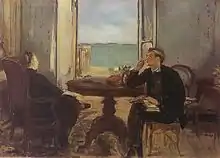
An excellent pianist, Leenhoff was initially hired in 1851 by Manet's father, Auguste, as a piano teacher for Édouard and his brothers. Auguste was a domineering figure in Édouard's life, insisting that his son study law and avoid the arts. In their early twenties, Suzanne and Édouard developed a personal relationship and were romantically involved for some ten years. After Édouard left his parents' home, he and Suzanne lived together, although they kept their relationship discreet and secret, especially from Édouard's father. (Leenhoff may also have been Auguste's mistress.) Leenhoff gave birth out of wedlock to a son, Léon-Edouard Koëlla, on 29 January 1852. The birth certificate gave Leenhoff as the mother but "Koëlla" as the father, an individual never identified and likely invented. Léon was baptised in 1855, and became known as Suzanne's young brother.[1] Suzanne and Édouard were finally married in October 1863, a year after the death of Édouard's father.[2] Édouard never publicly confirmed Léon as his son.[1] Some report that the father could have been Manet's own father, Auguste.[3][4]
Léon posed often for Édouard Manet. Most famously, he is the subject of the Boy Carrying a Sword of 1861 (Metropolitan Museum of Art, New York) and Boy Blowing Bubbles (Calouste Gulbenkian Museum, Lisbon). He also appears as the boy carrying a tray in the background of The Balcony.[5]
Portrait by Degas
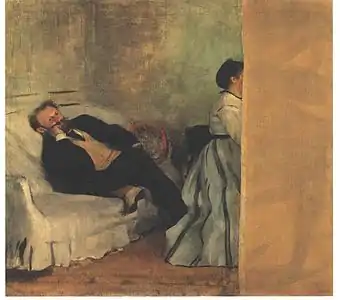
Édouard Manet and Edgar Degas met by chance at the Louvre in 1862, and after an intense conversation and Manet's demonstration on the art of etching, they became lifelong friends. Sometime in 1868 Degas painted a portrait of Manet and his wife. Manet is reclining on a couch and Suzanne appears to be seated at a piano. The mystery that surrounds the portrait by Degas is the fact that the painting has been slashed from top to bottom and right through the likeness of Suzanne. The supposition is that Manet, for an unknown reason, cut the painting. Manet might have slashed the painting because he did not like the way Suzanne was painted, or because he was feuding at the time with Degas, or he might have been angry with his wife. When Degas saw what had been done to his painting he demanded its return, and he took it back. Degas intended to re-paint the likeness of Suzanne at the piano and he reiterated his intention to Ambroise Vollard in conversation with him around the turn of the century. Degas never got around to fixing the painting and it remains in its slashed state in the Kitakyushu Municipal Museum of Art in Japan.[6] [7] [8]
Suzanne as a model
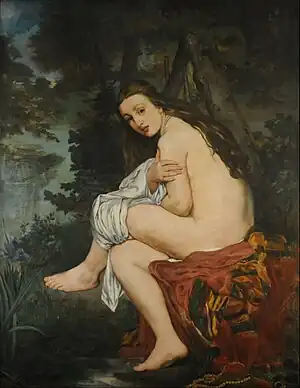 Édouard Manet, The Startled Nymph, 1859-1861
Édouard Manet, The Startled Nymph, 1859-1861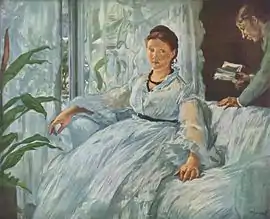 Édouard Manet, The Reading, 1868
Édouard Manet, The Reading, 1868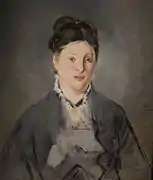 Édouard Manet, Madame Manet, Norton Simon Museum, 1874-1876
Édouard Manet, Madame Manet, Norton Simon Museum, 1874-1876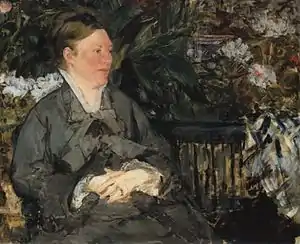 Édouard Manet, Mme. Manet in The Greenhouse, 1879
Édouard Manet, Mme. Manet in The Greenhouse, 1879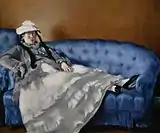 Édouard Manet, Mme. Manet, On A Blue Sofa, c. 1880
Édouard Manet, Mme. Manet, On A Blue Sofa, c. 1880 Édouard Manet, Mme Manet in the garden of Bellevue, 1880, Metropolitan Museum of Art
Édouard Manet, Mme Manet in the garden of Bellevue, 1880, Metropolitan Museum of Art
References
- Brombert, Beth Archer (1994). "The Man with the Sword: Edouard Manet's Double-Edged Works". Nineteenth-Century French Studies. 22 (3/4): 487–504. JSTOR 23537147.
- Manet 1832-1883, Françoise Cachin, p286.
- "Manet, Vermeer, Valesquez and the boy in "The Luncheon"". leslieparke.com. 2 March 2023. Archived from the original on 19 May 2023. Retrieved 19 May 2023.
And might these two people be standing in for Leon's real parents -- Suzanne as the maid (as she was the piano teacher) and Manet's father as the man.
- "The Mystery of Leon, Édouard Manet's Son". bonjourparis.com. 4 September 2018. Archived from the original on 3 April 2023. Retrieved 19 May 2023.
The respected art critic Waldemar Januszcak believed that not only was Auguste the real father of Leon, but was also the influence behind Manet's most iconic painting, Déjeuner sur L'Herbe. This was the painting that scandalized Paris in 1863: the brazen nude lolling outdoors in a park between two fully clothed gentlemen.
- Mauner, G. L., & Loyrette, H. Manet: the still-life paintings. New York: H.N. Abrams in association with the American Federation of Arts, 2000. p. 66. ISBN 0-8109-4391-3.
- Manet 1832-1883, Paul-André Lemoisne, pp140-142.
- "ART; Degas and Mrs. Manet". The New York Times. 22 March 1992. Retrieved 19 May 2023.
The next time Degas saw his picture, it had been mutilated, slashed right through the face of Suzanne Manet at the piano. She had been sitting in profile, and the cut went straight through her temple. Everything to the right of that had been destroyed. Degas was naturally furious, and if Manet offered any explanation, it has not been preserved.
- "Degas and Manet's 'mix of friendship and rivalry' chronicled in major new show". The Art Newspaper. 2 March 2023. Archived from the original on 31 March 2023. Retrieved 19 May 2023.
It was Manet himself who wielded the penknife. Degas had given the double portrait to the couple, but at some point Manet could no longer bear what he called "a deformation" of Suzanne's features, and took the knife to the canvas. You can imagine the scene when Degas—a famously fractious figure—discovered the mutilation. He took the painting back and returned to Manet a still life that he had given him.
Further reading
- Suzanne en Edouard Manet: De liefde van een Hollandse pianiste en een Parijse schilder by nl: Thera Coppens, 2014. ISBN 978-9029088565, ASIN 9029088567.
- Françoise Cachin in collaboration with Michel Melot: Manet 1832–1883. Réunion des Musées Nationaux, Paris, The Metropolitan Museum of Art, New York, Harry N. Abrams, Inc., New York 1983, ISBN 0-87099-349-6.
- Jean Sutherland Boggs, Henry Loyrette, Michael Pantazzi, Gary Tinterow, Degas, Réunion des Musées Nationaux, Paris, The Metropolitan Museum of Art, New York, National Gallery of Canada, Ottawa, New York 1988, ISBN 0-87099-520-0.
- A. van Anrooy: Impromptu Zaltbommel 1982 ISBN 90-288-1620-8
- Otto Friedrich: Edouard Manet und das Paris seiner Zeit Kiepenheuer & Witsch 1994 ISBN 3-462-02366-7
- Nancy Locke: Manet and the Family Romance Princeton University Press 2001 ISBN 0-691-05060-0
- Gotthard Jedlicka: Manet Zürich 1941
- Toon van Kempen, Nicoline van de Beek Madame Manet Uitgeverij Het Archiefcollectief 2016 ISBN 978-9-08-230731-3